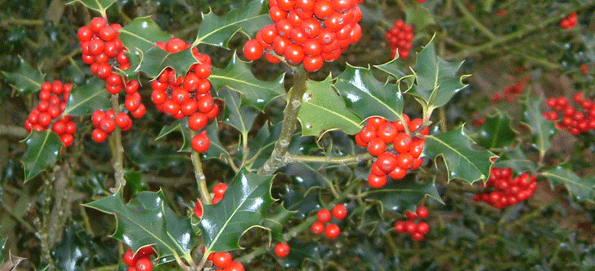
Wildlife in December
To many of us December means Christmas and although much of the countryside is bare there are a number of plants and animals closely associated with this time of year.
It is now, perhaps more than any other time that we bring plants from the countryside into our home, and many of these can naturally be found around Moors Valley.
Evergreens such as holly, with its rosy berries (but only on the females plants) are used in wreaths, along with ivy and fir cones too. Holly berries form an important food source for many birds and small mammals, so it is important to leave them some as well. Remember to feed the garden birds as well as give them some water as the weather can be extremely harsh from this month onwards.
Ivy is unusual in that it has two types of leaves; the well known lobed one as well as the larger, spear-shaped leaves that are found on the flowering stems.
The Victorians introduced the idea of the Christmas tree. The traditional variety is Norway spruce, although now it is possible to get a variety of species. Why not buy your tree at the Christmas Tree Shop here at Moors Valley during December and get your choice of a wide range of varieties, including the non-drop lodgepole pine and noble fir varieties.
The robin, so often associated with the festive season, can be particularly tame during the colder months. Robins are one of the few birds that can be heard singing during winter, as both the males and females maintain territories for feeding during this period, which may be their breeding territories later. Around Christmas-time robins begin exploring other robins’ territories looking for a mate. They then pair up by mid-January and females stop singing.
Mistletoe grows in fruit trees, such as apple and lime. Now that the leaves have fallen the mistletoe is especially noticeable. This semi-parasitic plant is best seen in winter. Although it does feed off its host tree it does also contain the green pigment called chlorophyll, and is therefore able to create its own food through photosynthesis. The plant is associated with the mistle thrush which is supposed to love the sticky white berries. The bird spreads the plant from tree to tree by wiping the excess seeds and berries from its beak onto a twig of another tree.
Other things to look out for:
- The red stems of dogwood around Moors Lake look particularly attractive during the frosts in December.
- The resident birds can struggle to find food during the winter, so the Rangers will keep the feeders around the Visitor Centre topped up with seed to give them a little help.
- The prickly gorse will still bare its bright yellow flowers even in December as it flowers all year round.
- Sometimes bird boxes are used by birds such as blue tits, great tits and wrens to provide extra overnight shelter.







